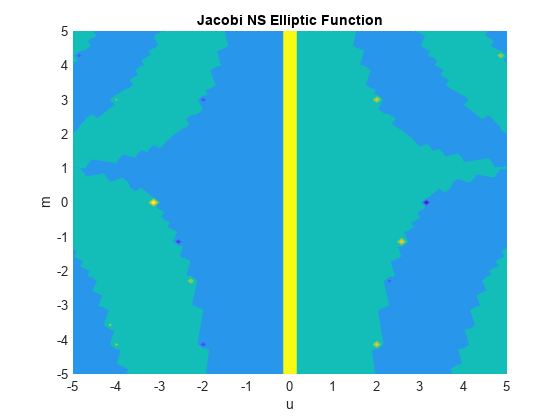jacobiNS
Jacobi NS elliptic function
Syntax
Description
jacobiNS(
returns the Jacobi NS Elliptic Function of
u,m)u and m. If u or
m is an array, then jacobiNS acts
element-wise.
Examples
Calculate Jacobi NS Elliptic Function for Numeric Inputs
jacobiNS(2,1)
ans =
1.0373Call jacobiNS on array inputs.
jacobiNS acts element-wise when
u or m is an array.
jacobiNS([2 1 -3],[1 2 3])
ans =
1.0373 1.4879 1.7321Calculate Jacobi NS Elliptic Function for Symbolic Numbers
Convert numeric input to symbolic form using
sym, and find the Jacobi NS elliptic function. For
symbolic input where u = 0 or m = 0 or
1, jacobiNS returns exact symbolic
output.
jacobiNS(sym(2),sym(1))
ans = coth(2)
Show that for other values of u or
m, jacobiNS returns an
unevaluated function call.
jacobiNS(sym(2),sym(3))
ans = jacobiNS(2, 3)
Find Jacobi NS Elliptic Function for Symbolic Variables or Expressions
For symbolic variables or expressions,
jacobiNS returns the unevaluated function call.
syms x y f = jacobiNS(x,y)
f = jacobiNS(x, y)
Substitute values for the variables by using subs, and
convert values to double by using double.
f = subs(f, [x y], [3 5])
f = jacobiNS(3, 5)
fVal = double(f)
fVal = 32.1081
Calculate f to higher precision using
vpa.
fVal = vpa(f)
fVal = 32.108111189955611054545195854805
Plot Jacobi NS Elliptic Function
Plot the Jacobi NS elliptic function using fcontour. Set u on the x-axis and m on the y-axis by using the symbolic function f with the variable order (u,m). Fill plot contours by setting Fill to on.
syms f(u,m) f(u,m) = jacobiNS(u,m); fcontour(f,'Fill','on') title('Jacobi NS Elliptic Function') xlabel('u') ylabel('m')

Input Arguments
u — Input
number | vector | matrix | multidimensional array | symbolic number | symbolic variable | symbolic vector | symbolic matrix | symbolic multidimensional array | symbolic function | symbolic expression
Input, specified as a number, vector, matrix, or multidimensional array, or a symbolic number, variable, vector, matrix, multidimensional array, function, or expression.
m — Input
number | vector | matrix | multidimensional array | symbolic number | symbolic variable | symbolic vector | symbolic matrix | symbolic multidimensional array | symbolic function | symbolic expression
Input, specified as a number, vector, matrix, or multidimensional array, or a symbolic number, variable, vector, matrix, multidimensional array, function, or expression.
More About
Jacobi NS Elliptic Function
The Jacobi NS elliptic function is
ns(u,m) = 1/ds(u,m)
where ds is the respective Jacobi elliptic function.
The Jacobi elliptic functions are meromorphic and doubly periodic in their first
argument with periods 4K(m) and 4iK'(m), where K is the complete elliptic integral of the first kind, implemented
as ellipticK.
Version History
Introduced in R2017b
MATLAB-Befehl
Sie haben auf einen Link geklickt, der diesem MATLAB-Befehl entspricht:
Führen Sie den Befehl durch Eingabe in das MATLAB-Befehlsfenster aus. Webbrowser unterstützen keine MATLAB-Befehle.

Select a Web Site
Choose a web site to get translated content where available and see local events and offers. Based on your location, we recommend that you select: .
You can also select a web site from the following list:
How to Get Best Site Performance
Select the China site (in Chinese or English) for best site performance. Other MathWorks country sites are not optimized for visits from your location.
Americas
- América Latina (Español)
- Canada (English)
- United States (English)
Europe
- Belgium (English)
- Denmark (English)
- Deutschland (Deutsch)
- España (Español)
- Finland (English)
- France (Français)
- Ireland (English)
- Italia (Italiano)
- Luxembourg (English)
- Netherlands (English)
- Norway (English)
- Österreich (Deutsch)
- Portugal (English)
- Sweden (English)
- Switzerland
- United Kingdom (English)